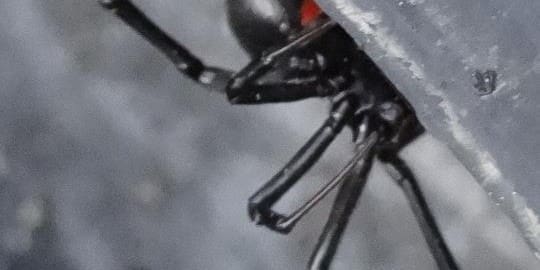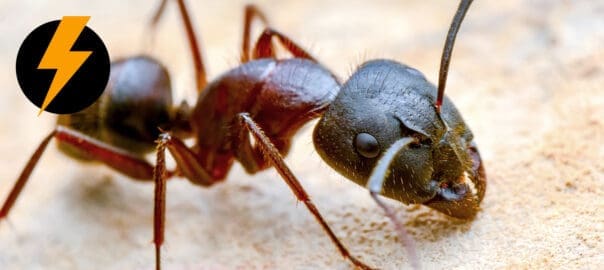The good news? We know what they are and how to address each, so the problem can be solved. It’s time to kick the worries out with the pests! We walk through the top ways pests are getting in and how you can protect each area of your home with a few simple steps.
What are the Most Common Pest Entry Points into the Home?
Doorways and Windows
Gaps around doors and window frames are often the greatest culprit when it comes to pests entering your home. In many cases, homeowners have exterior doorways with sizable gaps that allow pests to squeeze inside… and these gaps may be newly formed. Because doors endure so much use and wear, it’s easy for openings to form over time. Additionally, the natural shifting of home foundations and house “settling” can widen spaces around your door frames.
It’s important to check the seals around your doors and windows at the start of every season. Even the smallest gap or crack can be a welcome invitation to pests. Spiders and insects (even the biggest cockroaches) are capable contortionists, but so are rodents. Mice are even able to fit through gaps as small as ¼ inch! If daylight can pass through an opening from the outside, so can a wide variety of household nuisances.
Weatherstripping can be added to windows, door jambs, and door frames to create tight seals, and door sweeps can be attached to the bottom of doors to fill-in gaps. Window screens and screen doors with holes should be replaced, and windows should also be carefully inspected for any cracks or spaces around the seals. Garage doors can also present opportunities for pests if the door doesn’t make a proper seal against the ground, a garage door specialist can replace the rubber strip at the bottom of the door.
Foundations and Siding
The walls of your castle can be a huge vulnerability if left unchecked. Shifting ground and weather conditions can put cracks in your home’s foundation or gaps in your home’s siding. Even if these gaps appear too small to worry about, they might not be; spiders and other insects can pass through openings the width of a credit card. Exterior caulk and foundation gap fillers should be employed to seal any openings around the base and walls of the home.
Vents
Exhaust vents in the side or roof of your home carry out furnace fumes, remove excess moisture, and balance interior air pressure – so they’re important openings into your house. But that doesn’t mean critters of all sorts can’t use them for entry. A screen or metal mesh can be placed over these vents to prevent pests like squirrels or roof rats from coming inside – and many homes already have these screens in place. Screens should be added and maintained, but for overall home safety, it’s important to never obstruct air flow out of these ventilation components. Cracks or gaps around these vents should be treated the same as all other exterior gaps and should be filled with exterior caulk or roofing tar.
Landscaping Features
If that beautiful tree in your yard is getting too close to your roof, it may turn into a problem… and not just for the roof. Plant limbs and gardening features can act as highways into your house for opportunistic pests. All tree limbs, shrubberies, and plants should be regularly trimmed back from roofs and walls to prevent access. Debris and clutter in the yard or around the exterior of the home should be eliminated to remove possible foraging and breeding grounds for pests. Firewood – and all other forms of wood, cardboard, or paper – should be stored a minimum of 20 feet from the home in order to prevent termite and carpenter ant infestations.
You
Once the house is sealed and bridges for pests are removed, your home still has one major vulnerability: you. Your family, your pets, and you yourself might be carrying unwanted hitchhikers into your house. These stowaways might be dreaded bed bugs, fleas, ticks, or other advantageous insects.
Here, caution is key. When traveling, check the furniture for bed bugs ahead of time. When you return home from a trip, inspect your luggage carefully, and unpack on a hard surface. Clothes and luggage should be washed immediately after arriving home.
Additionally, it’s not a good idea to bring “free” used furniture in from outside. It may be free now, but you’ll be paying for it later.
To keep fleas and ticks at bay, inspect yourself, your children, and your pets when returning home after outdoor activities.
Let Bug Zapper Transform Your Home into a Fortress
Do you need a 100% guarantee that your home will be secure? We’ve got you covered.
At Bug Zapper, we’re not just the #1 ranking pest control service in Oregon – we’re also licensed, bonded, and fully insured specialty contractors (Oregon CCB #153907) – and no pest exclusion job is too big or too small for our team. We tailor all of our exclusion, prevention, and treatment plans specific to the customer. Every homeowner and home is unique and special, and we believe every treatment plan should be, too! We’re famous for our amazing customer care and outstanding services, and that’s why we’re able to back every job with a 100% guarantee of quality and satisfaction.
If you have questions, concerns, or if you need a hand, Bug Zapper can put your worries to rest. Contact one of our personable and knowledgeable technicians today!
Learn More: Bug Zapper Rodent Exclusion and Pest Proofing Methods


 Rats in Oregon: Understanding Rodents in the Pacific Northwest
Rats in Oregon: Understanding Rodents in the Pacific Northwest Town and Country Pest: Your Local Pest Solutions
Town and Country Pest: Your Local Pest Solutions Black Widow Spiders in Oregon – Danger!
Black Widow Spiders in Oregon – Danger! Kinds of Ants: Identifying Common Ants in Oregon
Kinds of Ants: Identifying Common Ants in Oregon